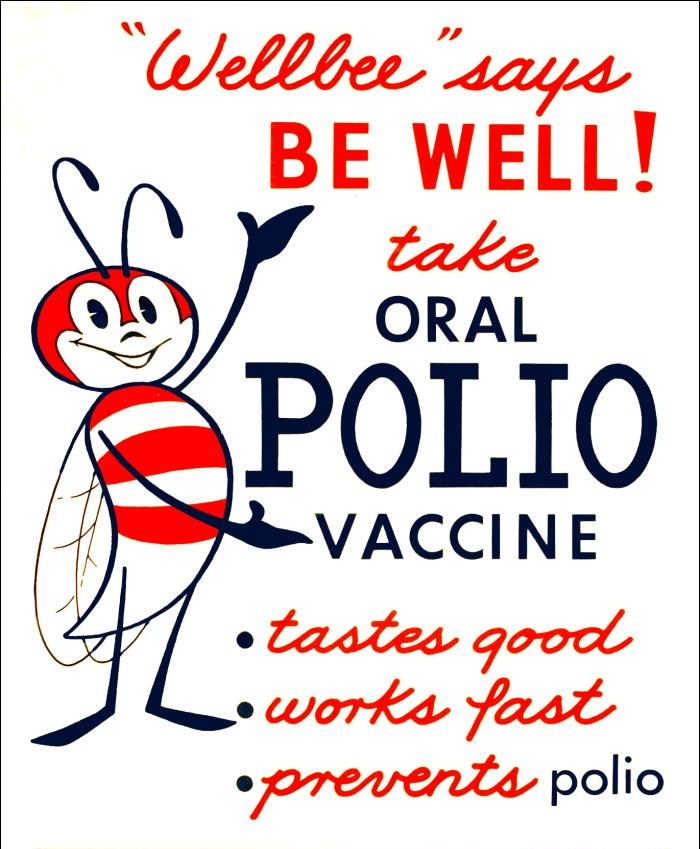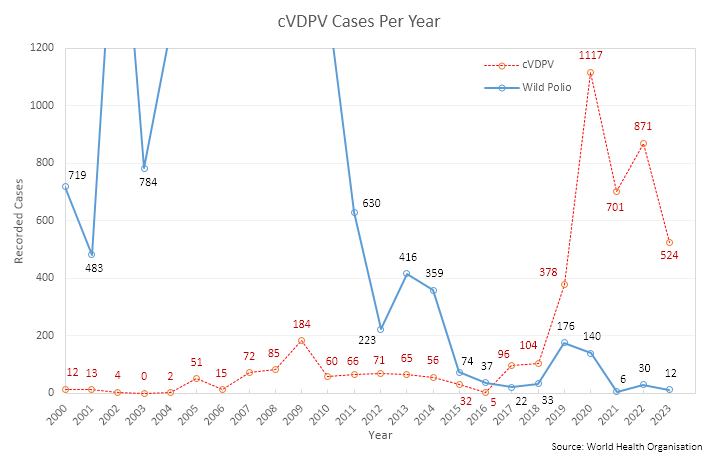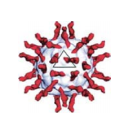|
Poliomyelitis
Poliomyelitis, commonly shortened to polio, is an infectious disease caused by the poliovirus. Approximately 70% of cases are asymptomatic; mild symptoms which can occur include sore throat and fever; in a proportion of cases more severe symptoms develop such as headache, neck stiffness, and paresthesia. These symptoms usually pass within one or two weeks. A less common symptom is permanent paralysis, and possible death in extreme cases.. Years after recovery, post-polio syndrome may occur, with a slow development of muscle weakness similar to that which the person had during the initial infection. Polio occurs naturally only in humans. It is highly infectious, and is spread from person to person either through fecal-oral transmission (e.g. poor hygiene, or by ingestion of food or water contaminated by human feces), or via the oral-oral route. Those who are infected may spread the disease for up to six weeks even if no symptoms are present. The disease may be diagnosed ... [...More Info...] [...Related Items...] OR: [Wikipedia] [Google] [Baidu] |
Polio Vaccine
Polio vaccines are vaccines used to prevent poliomyelitis (polio). Two types are used: an inactivated poliovirus given by injection (IPV) and a weakened poliovirus given by mouth (OPV). The World Health Organization (WHO) recommends all children be fully vaccinated against polio. The two vaccines have eliminated polio from most of the world, and reduced the number of cases reported each year from an estimated 350,000 in 1988 to 33 in 2018. The inactivated polio vaccines are very safe. Mild redness or pain may occur at the site of injection. Oral polio vaccines cause about three cases of vaccine-associated paralytic poliomyelitis per million doses given. This compares with 5,000 cases per million who are paralysed following a polio infection. Both types of vaccine are generally safe to give during pregnancy and in those who have HIV/AIDS but are otherwise well. However, the emergence of circulating vaccine-derived poliovirus (cVDPV), a form of the vaccine virus that has re ... [...More Info...] [...Related Items...] OR: [Wikipedia] [Google] [Baidu] |
Polio Vaccine
Polio vaccines are vaccines used to prevent poliomyelitis (polio). Two types are used: an inactivated poliovirus given by injection (IPV) and a weakened poliovirus given by mouth (OPV). The World Health Organization (WHO) recommends all children be fully vaccinated against polio. The two vaccines have eliminated polio from most of the world, and reduced the number of cases reported each year from an estimated 350,000 in 1988 to 33 in 2018. The inactivated polio vaccines are very safe. Mild redness or pain may occur at the site of injection. Oral polio vaccines cause about three cases of vaccine-associated paralytic poliomyelitis per million doses given. This compares with 5,000 cases per million who are paralysed following a polio infection. Both types of vaccine are generally safe to give during pregnancy and in those who have HIV/AIDS but are otherwise well. However, the emergence of circulating vaccine-derived poliovirus (cVDPV), a form of the vaccine virus that has re ... [...More Info...] [...Related Items...] OR: [Wikipedia] [Google] [Baidu] |
Poliovirus
A poliovirus, the causative agent of polio (also known as poliomyelitis), is a serotype of the species '' Enterovirus C'', in the family of ''Picornaviridae''. There are three poliovirus serotypes: types 1, 2, and 3. Poliovirus is composed of an RNA genome and a protein capsid. The genome is a single-stranded positive-sense RNA (+ssRNA) genome that is about 7500 nucleotides long. The viral particle is about 30 nm in diameter with icosahedral symmetry. Because of its short genome and its simple composition—only RNA and a nonenveloped icosahedral protein coat that encapsulates it—poliovirus is widely regarded as the simplest significant virus. Poliovirus was first isolated in 1909 by Karl Landsteiner and Erwin Popper. The structure of the virus was first elucidated in 1958 using X-ray diffraction by a team at Birkbeck College led by Rosalind Franklin, showing the polio virus to have icosahedral symmetry. In 1981, the poliovirus genome was published by two different ... [...More Info...] [...Related Items...] OR: [Wikipedia] [Google] [Baidu] |
Poliovirus
A poliovirus, the causative agent of polio (also known as poliomyelitis), is a serotype of the species '' Enterovirus C'', in the family of ''Picornaviridae''. There are three poliovirus serotypes: types 1, 2, and 3. Poliovirus is composed of an RNA genome and a protein capsid. The genome is a single-stranded positive-sense RNA (+ssRNA) genome that is about 7500 nucleotides long. The viral particle is about 30 nm in diameter with icosahedral symmetry. Because of its short genome and its simple composition—only RNA and a nonenveloped icosahedral protein coat that encapsulates it—poliovirus is widely regarded as the simplest significant virus. Poliovirus was first isolated in 1909 by Karl Landsteiner and Erwin Popper. The structure of the virus was first elucidated in 1958 using X-ray diffraction by a team at Birkbeck College led by Rosalind Franklin, showing the polio virus to have icosahedral symmetry. In 1981, the poliovirus genome was published by two different ... [...More Info...] [...Related Items...] OR: [Wikipedia] [Google] [Baidu] |
Post-polio Syndrome
Post-polio syndrome (PPS, poliomyelitis sequelae) is a group of latent symptoms of poliomyelitis (polio), occurring at about a 25–40% rate (latest data greater than 80%). These symptoms are caused by the damaging effects of the viral infection on the nervous system. Symptoms typically occur 15 to 30 years after an initial acute paralytic attack. Symptoms include decreasing muscular function or acute weakness with pain and fatigue. The same symptoms may also occur years after a nonparalytic polio (NPP) infection. The precise mechanism that causes PPS is unknown. It shares many features with chronic fatigue syndrome, but unlike that disorder it tends to be progressive and can cause loss of muscle strength. Treatment is primarily limited to adequate rest, conservation of available energy, and supportive measures, such as leg braces and energy-saving devices such as powered wheelchairs, analgesia (pain relief), and sleep aids. Signs and symptoms After a period of prolonged sta ... [...More Info...] [...Related Items...] OR: [Wikipedia] [Google] [Baidu] |
Post-polio Syndrome
Post-polio syndrome (PPS, poliomyelitis sequelae) is a group of latent symptoms of poliomyelitis (polio), occurring at about a 25–40% rate (latest data greater than 80%). These symptoms are caused by the damaging effects of the viral infection on the nervous system. Symptoms typically occur 15 to 30 years after an initial acute paralytic attack. Symptoms include decreasing muscular function or acute weakness with pain and fatigue. The same symptoms may also occur years after a nonparalytic polio (NPP) infection. The precise mechanism that causes PPS is unknown. It shares many features with chronic fatigue syndrome, but unlike that disorder it tends to be progressive and can cause loss of muscle strength. Treatment is primarily limited to adequate rest, conservation of available energy, and supportive measures, such as leg braces and energy-saving devices such as powered wheelchairs, analgesia (pain relief), and sleep aids. Signs and symptoms After a period of prolonged sta ... [...More Info...] [...Related Items...] OR: [Wikipedia] [Google] [Baidu] |
Flaccid Paralysis
Flaccid paralysis is a neurological condition characterized by weakness or paralysis and reduced muscle tone without other obvious cause (e.g., trauma). This abnormal condition may be caused by disease or by trauma affecting the nerves associated with the involved muscles. For example, if the somatic nerves to a skeletal muscle are severed, then the muscle will exhibit flaccid paralysis. When muscles enter this state, they become limp and cannot contract. This condition can become fatal if it affects the respiratory muscles, posing the threat of suffocation. It also occurs in spinal shock stage in complete transection of spinal cord occurred in injuries like gunshots injuries.Saladin, Kenneth S. Anatomy & Physiology: The Unity of Form and Function. McGraw-Hill. 6th Edition. 2012. Causes Polio and other viruses The term ''acute flaccid paralysis'' (AFP) is often used to describe an instance with a sudden onset, as might be found with polio. AFP is the most common sign of ... [...More Info...] [...Related Items...] OR: [Wikipedia] [Google] [Baidu] |
Flaccid Paralysis
Flaccid paralysis is a neurological condition characterized by weakness or paralysis and reduced muscle tone without other obvious cause (e.g., trauma). This abnormal condition may be caused by disease or by trauma affecting the nerves associated with the involved muscles. For example, if the somatic nerves to a skeletal muscle are severed, then the muscle will exhibit flaccid paralysis. When muscles enter this state, they become limp and cannot contract. This condition can become fatal if it affects the respiratory muscles, posing the threat of suffocation. It also occurs in spinal shock stage in complete transection of spinal cord occurred in injuries like gunshots injuries.Saladin, Kenneth S. Anatomy & Physiology: The Unity of Form and Function. McGraw-Hill. 6th Edition. 2012. Causes Polio and other viruses The term ''acute flaccid paralysis'' (AFP) is often used to describe an instance with a sudden onset, as might be found with polio. AFP is the most common sign of ... [...More Info...] [...Related Items...] OR: [Wikipedia] [Google] [Baidu] |
List Of Childhood Diseases
The term childhood disease refers to disease that is contracted or becomes symptomatic before the age of 18 or 21 years old. Many of these diseases can also be contracted by adults. Some childhood diseases include: Diseases from three years to five years * Candida albicans infection * Candida parapsilosis infection * Cytomegalovirus infection * diphtheria * human coronavirus infection * respiratory distress syndrome * measles * meconium aspiration syndrome * metapneumovirus (hMPV) infection * Necrotizing enterocolitis * Gonorrhea infection of the newborn * parainfluenza (PIV) infection * pertussis * poliomyelitis * prenatal Listeria * Group B streptoccus infection * Tay–Sachs disease * tetanus * Ureaplasma urealyticum infection * respiratory Syncytial Virus infection * rhinovirus; common cold * Diabetes (Type 2) typhiod malaria celiac e coli Diseases of older children * Common cold * AIDS * Anemia * Asthma * Bronchiolitis * Cancer * Candidiasis ("Thr ... [...More Info...] [...Related Items...] OR: [Wikipedia] [Google] [Baidu] |
Fecal–oral Route
The fecal–oral route (also called the oral–fecal route or orofecal route) describes a particular route of transmission of a disease wherein pathogens in fecal particles pass from one person to the mouth of another person. Main causes of fecal–oral disease transmission include lack of adequate sanitation (leading to open defecation), and poor hygiene practices. If soil or water bodies are polluted with fecal material, humans can be infected with waterborne diseases or soil-transmitted diseases. Fecal contamination of food is another form of fecal-oral transmission. Washing hands properly after changing a baby's diaper or after performing anal hygiene can prevent foodborne illness from spreading. The common factors in the fecal-oral route can be summarized as five Fs: fingers, flies, fields, fluids, and food. Diseases caused by fecal-oral transmission include typhoid, cholera, polio, hepatitis and many other infections, especially ones that cause diarrhea. Backgro ... [...More Info...] [...Related Items...] OR: [Wikipedia] [Google] [Baidu] |
Infectious Disease
An infection is the invasion of tissues by pathogens, their multiplication, and the reaction of host tissues to the infectious agent and the toxins they produce. An infectious disease, also known as a transmissible disease or communicable disease, is an illness resulting from an infection. Infections can be caused by a wide range of pathogens, most prominently bacteria and viruses. Hosts can fight infections using their immune system. Mammalian hosts react to infections with an innate response, often involving inflammation, followed by an adaptive response. Specific medications used to treat infections include antibiotics, antivirals, antifungals, antiprotozoals, and antihelminthics. Infectious diseases resulted in 9.2 million deaths in 2013 (about 17% of all deaths). The branch of medicine that focuses on infections is referred to as infectious disease. Types Infections are caused by infectious agents (pathogens) including: * Bacteria (e.g. '' Mycobacterium tube ... [...More Info...] [...Related Items...] OR: [Wikipedia] [Google] [Baidu] |
Central Nervous System
The central nervous system (CNS) is the part of the nervous system consisting primarily of the brain and spinal cord. The CNS is so named because the brain integrates the received information and coordinates and influences the activity of all parts of the bodies of bilaterally symmetric and triploblastic animals—that is, all multicellular animals except sponges and diploblasts. It is a structure composed of nervous tissue positioned along the rostral (nose end) to caudal (tail end) axis of the body and may have an enlarged section at the rostral end which is a brain. Only arthropods, cephalopods and vertebrates have a true brain (precursor structures exist in onychophorans, gastropods and lancelets). The rest of this article exclusively discusses the vertebrate central nervous system, which is radically distinct from all other animals. Overview In vertebrates, the brain and spinal cord are both enclosed in the meninges. The meninges provide a barrier to chemicals ... [...More Info...] [...Related Items...] OR: [Wikipedia] [Google] [Baidu] |






